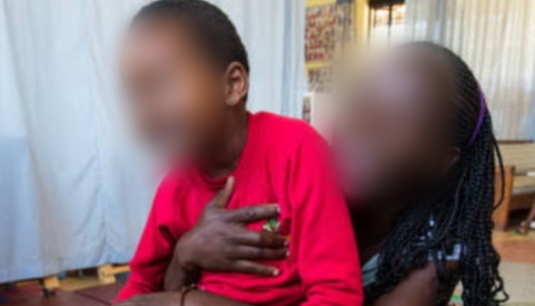Juliet Omondi’s daughter is 9 years and two months old. She was born in July 2012. Juliet had a smooth pregnancy up until her thirty fourth week when she went for her second scan.
The scan revealed that her baby’s umbilical cord was choking her. Juliet was told that she could not deliver the baby through normal delivery. She was put on an emergency cesarean section.
“After birth, my daughter was placed in the intensive care unit. She had contracted a lung infection during birth and stayed at the ICU for 5 days. On the sixth day, she was transferred to the Special Care Unit,” says Juliet.
By the second week, the baby had not managed to open her eyes. The doctors sought help from a neurosurgeon who performed a CT Scan. The scan revealed that she had developed a blood clot in the brain.
This was very strange, the doctor said. Apparently, cases of babies developing blood clots in the brain were more likely to happen during normal deliveries.
Juliet’s baby had also developed hydrocephalus, which is the accumulation of cerebrospinal fluid within the brain. Her head started getting bigger by the day as the fluid exerted pressure inside her skull.
“The doctor said that if the fluid would not clear, a surgical exercise to insert a cerebral shunt which would be draining the ‘water’ from the head to the stomach would be performed,” she says.
Luckily, the clot started to clear on its own. Five weeks later, Juliet and her baby were discharged.
But trouble kicked in again 7 months later when Juliet noticed that her daughter’s development was very slow.
At seven months, she could not sit down by herself because of the weight of her head. Her general body weight gain was very minimal too. This was compounded when she contracted malaria.
Despite receiving quick treatment, she started having seizures. The seizures became so severe and recurrent that for two years, she would have seizures every day. Juliet consulted a pediatrician who put the baby on anticonvulsants and supplements.
“She sat independently at age one year, and continued to sit up without progress for one year and nine months,” she says.
Juliet was referred to a pediatric neurologist at the Gertrude Children’s Hospitals who performed an EEG examination – which is a medical evaluation of brain waves and activities.
Unlike the previous hydrocephalus diagnosis, this examination revealed that her daughter had autism spectrum disorder. She was recommended for occupational and physiotherapy, and anticonvulsants.
Within weeks, she started crawling. Juliet says that today, her baby can call out a few words such as ‘Mum’ and ‘Baba’. Her eye contact has also improved and she is sleeping longer unlike before when she could hardly sleep through the night.
Juliet also says that she has put her baby on a medical approach known as Nemecheck Protocol, which aims to help with the recovery and, or reversal of autism, in order to help her cope with her condition better.
Juliet’s daughter is one of many children in Kenya who are battling autism. According to the World Health Organization, about one in every 160 children across the world has autism.
With autism in children, there are several conditions within autism that require separate diagnosis. These include pervasive developmental disorder – not otherwise specified (PDD-NOS), the Asperger syndrome, childhood disintegrative disorder, and the autistic disorder.
In 2013, the term autism which was used to describe this condition was changed to autism spectrum disorder by the American Psychiatric Association. According to the Centre for Disease Control (CDC), Autism Spectrum Disorder is a developmental disability that results in social, behavioural and communication challenges.
If your child has autism he or she may find difficulty in comprehending simple things or commands or even phrases that are used in every day social interactions.
“Children with autism have problems in understanding the literal meaning of words, emotions and instructions. This often leads people who don’t know about the diagnosis into assuming such children are difficult or notorious,” says general physician Dr. James Mbuthia.
Autism is not a life threatening condition. However, it blocks the timely realization of childhood milestones.
For example, says Dr. Mbuthia, a child with autism will tend to take longer to speak or go tell the urge to go to the toilet on their own.
Causes
According to Dr. Mbuthia, autism has no specific cause. It can be caused by a range of factors that range from genetic to environmental.
“Autism spectrum disorder is linked with genetic disorders like feeble X syndrome or Rett syndrome in some children. In others, autism is the result of genetic mutations,” he says.
Dr. Mbuthia also says that environmental influences such as complicated pregnancies and viral infections play a role in the onset of autism spectrum disorder.
Beyond causes, there are certain risk factors that put babies at risk of autism spectrum disorder. According to the CDC, these include:
- The parents’ age during pregnancy: Babies born to older parents are at an increased risk than babies born to younger parents.
- Pregnancy complications: Babies born at 26 weeks are at a higher risk of developing autism spectrum disorder than babies born at maturity. Babies born with too low birth weight and multiple pregnancies such as triplets are a risk for autism.
- Gender: Baby boys are more likely to develop autism than baby girls.
- Family: If a family has a baby with autism, chance of having another baby with the same condition are higher.
- Pregnancy spacing: Pregnancies that occur less than one year apart put babies at higher risk of autism than pregnancies that are better spaced.
Why high blood pressure can kill you in a heartbeat
Symptoms and risk factors to watch out for
There are symptoms and risk factors that point to the possibility of autism. The majority of signs and symptoms of autism are linked to social, emotional, and communication skill deficiencies.
According to the CDC, your child should be professionally examined for autism if:
- They are not able to respond to their name by one year of age
- They are not able to point at objects as a way of showing their interest by age of one year and four months.
- They always seem to be avoiding eye contact with you or the people close to him, and instead prefer to be alone.
- They have intense or unusual reactions to tastes, feelings, smell, and looks.
- They are quick to anger.
- They have a tendency to flap their hands, spin in circles, or rock their bodies.
- They have trouble adapting whenever a routine around them changes.
- They tend to repeat or echo words and phrases said to them.
Diagnosis of autism
There are several methods and stages that are used to diagnose autism. According to the CDC, diagnosing a child with autism can be a lengthy and difficult process.
This is mainly because there is no specific medical tests such as blood tests that can be used to develop a diagnosis.
Instead, your child’s pediatrician will look at your child’s development, growth and behaviours to come up with a diagnosis.
“Autism spectrum disorder can be properly diagnosed between 18 months and two years. However, many children with autism receive a final autistic diagnosis when they are much older,” says the CDC.
Takeaway research
Children with autism are oftentimes confronted with behaviours that are not only challenging to them but also to their parents.
While some children with autism do not suffer too many behavioural challenges, others are on the extreme end of the autistic tether.
They are overwhelmed with behaviours that range from physical to non-physical aggression.
These behaviours include screaming, throwing tantrums, yelling, slapping, throwing objects, scratching, biting, kicking and in some cases, behaviours that inflict self-injury such hitting the head on the wall.
Developing research on easing these challenges by the Thompson Centre for Autism and Neurodevelopmental Disorders suggests that a new approach to the treatment procedures of autism can make it easier for both children and parents to adapt and cope in environments that are not too controlled.
“It is possible to reduce problem behaviours for kids with autism. Instead of constantly monitoring the child, the new flexible intervention technique allows for periodic check-ins to see if the child is engaging in problem behaviours and reward them if there are improvements,” said behavioural analyst Kyle Hamilton who is spearheading this research.
Dr. Hamilton said that this will allow these children to be around their typically developing peers more often in society which will foster their own development.
This research was published in the journal Current Developmental Disorders Reports.








